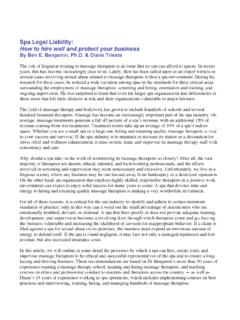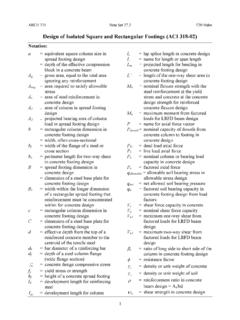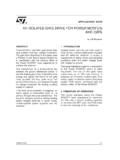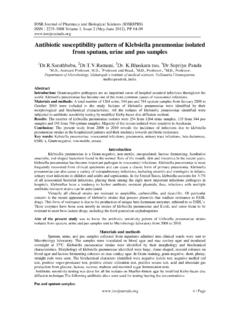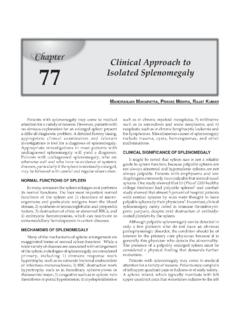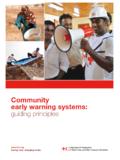Transcription of Discovering the Power of Aaron Mattes’ Active …
1 Discovering the Power of Aaron mattes '. Active isolated stretching By Ben Benjamin, with Jeffrey Haggquist, he field of massage therapy and bodywork encompasses a wide range of T different styles and approaches. Each of us brings a unique combination of skills that we've found to be effective over years of study and practice in areas ranging from sports medicine and orthopedic massage to relaxation mas- sage, craniosacral therapy, and a variety of ancient healing arts. There are few experiences more exciting than finding a new modality or technique to add to your repertoire that dramatically improves your ability to help clients. Over the past couple of years, I've been exploring one such modality that has exceeded all my expectations: Active isolated stretching (AIS), a system developed over the course of the past 37 years by kinesiologist Aaron mattes .
2 A Surprising Discovery Discovering AIS has been the second major turning point in my professional career. The first came in the late 1970s. At the time I was working quite successfully (running a small somatic therapy school, as well as a large private prac- tice), using techniques focused almost entirely on muscles. I was operating on the assumption that most pain and injury problems could be traced back to muscular tension and imbalances. It came as a great shock to learn that the majority of chronic pain is actually caused by injuries to fibrous connective tissues (ligaments, joints, tendons, and fascia). When I first heard this, I was highly skeptical. I wasn't convinced of the idea until I'd had it confirmed by direct experience, seeing Dr. James Cyriax's therapies give lasting pain relief to people who hadn't responded to any other therapies.
3 Those people included me receiving treatment for my own injuries eliminated the back and neck pain I'd felt for the previous 22 years (for which massage of the muscles had provided only partial relief). Learning how to assess and treat connective tissue injuries caused a radical shift in my thinking. I eagerly shared what I'd learned with my clients and students, and saw many pain conditions that I had previously assumed to be permanent or beyond my expertise respond readily to the new types of treatment. Over the past 30 years, I've devoted much of my life to refining, practicing, teaching, and writing about these techniques. Recently I've again had cause to question my assumptions about which musculoskeletal problems are likely to be permanent, and which can be resolved. From my earlier study with Dr.
4 Cyriax and my own work with clients, I. came to believe that in the majority of cases, a combination of friction treatment, myofascial therapy, massage techniques, and/or exercise therapy could effectively relieve chronic pain, build strength, and improve range of motion. When these were not sufficient, I could usually trust that either injection therapy or surgery would be suc- cessful. However, there were still various conditions that I thought of as untreatable, including declines in flexibili- ty due to aging, degenerative arthritis, or serious injury and muscular dysfunction due to progressive degenerative diseases such as multiple sclerosis (MS) or Parkinson's disease. I'm happy to say that AIS has proven me wrong. As in the previous instance, I initially came to AIS with a great deal of skepticism, and was convinced only by direct experience.
5 I've seen results in myself that I never thought possible: after receiving the work for just a few months, I achieved greater range of motion than I could ever remember having. Limitations that I'd attrib- uted to the inevitable effects of aging simply disappeared. Moreover, once I received AIS training and began incorporating it into my work with clients, I started seeing remarkable changes healing times for most soft- tissue injuries were cut in half, and some conditions that had been gradually worsening over time (including one individual's MS symptoms) began to reverse course. In this article, I'm going to outline the mechanisms of AIS, explain how and why it works, and discuss the specific ways in which it complements massage therapy and supports healing. In the process, I will highlight a variety of specific examples including some surprising results I've seen in my clients, in myself, and in other individuals I've encountered that demonstrate the usefulness, versatility, and Power of this approach.
6 How AIS Works The AIS method differs from most other types of stretching and strengthening programs in several important respects. Listed below are seven defining characteristics of AIS techniques. Each is supported by established principles of human physiology. Note that although this method is called Active isolated stretching , it actually incorporates both stretching and strengthening in almost every maneuver. ( Aaron mattes has also developed a complementary program focused more heavily on strengthening, which is outside the scope of this article.). 1. Specificity Characteristics AIS movements are precisely targeted to stretch individual muscles and parts of of AIS Stretches muscles, rather than larger muscle groups. (For instance, in contrast to a simple 1. Specificity forward bend that provides a general stretch for all aspects of the hamstring 2.)
7 Active initiation muscles, AIS uses six different stretches to focus on different combinations of the 3. Incremental assists medial, lateral, oblique, proximal, and distal fibers.) This enables the practitioner 4. Gentle motion to independently evaluate and then work to maximize the flexibility of 5. Brief duration each section of the muscle. There are AIS protocols for every primary muscle 6. Multiple repetitions in the body, amounting to more than 170 separate stretches. Using different combinations of these stretches, we can develop customized regimens tailored 7. Deep breathing to the specific needs of any client. 2. Active Initiation Although AIS stretches are supported and assisted by the practitioner, each movement is initiated by the client. This enhances the stretch, since contracting a muscle on one side of a joint causes the muscle on the opposite side to relax (a principle known as Sherrington's Law of Reciprocal Inhibition), and that relaxation helps the muscle to stretch more efficiently.
8 Moreover, having the muscles actively working helps to increase the temperature of the muscles and the fascia, which enhances flexibility even further. 3. Incremental Assists At the end of the client's Active range of motion, the practitioner provides just enough assistance to push slightly beyond what the person could do on his or her own. In this way it's possible to increase flexibility incrementally, typically adding two or three degrees with each repetition. Two of the six AIS hamstring stretches 4. Gentle Motion The movements involved in AIS are quite gentle, never approaching a muscle's maximum sustainable force ( , the level of force that will cause that muscle to give out). Laboratory studies confirm that to avoid injury, it's important to use 50% or less of the maximum force for the muscles being Gradual, gentle motion also helps to delay activation of the myotatic reflex (commonly referred to as the stretch reflex) a defensive mechanism that is designed to prevent muscles from stretching too far or too fast.
9 A movement that's overly sudden or severe will cause the muscle being stretched to reflexively contract. 5. Brief Duration The key to avoiding the stretch reflex altogether is to hold a stretch for only a short time no more than two seconds. Traditionally, exercise specialists have recommended holding stretches for much longer periods of time, up to 60 seconds. (This is referred to as static stretching .) However, research has shown that such pro- longed stretching initiates the stretch reflex, decreases blood flow within the tissue, and leads to a buildup of waste products, such as lactic acid, that contribute to muscle fatigue and When people stretch in this way, they're working against themselves, causing a contraction of the very muscles they're trying to lengthen (sort of like trying to drive a car with the parking brake on).
10 As a result, the tendons and ligaments get stretched more than the muscles, which can lead to tendon irritation and even laxity, and thus predispose these structures to future 6. Multiple Repetitions Static stretching relies on a principle known as stress relaxation: when muscles and connective tissues are held at a constant length, they eventually fatigue, release, and lengthen. In addition to promoting muscle fatigue, this type of action is also relatively slow. AIS achieves results much more quickly by using 6 to 10 repetitions of shorter stretches. This method can help increase the range of motion in a particular area by as much as 60 degrees in a relatively short period of time. 7. Deep Breathing Throughout an AIS session, the client coordinates his or her movements with regular, relaxed breathing.
